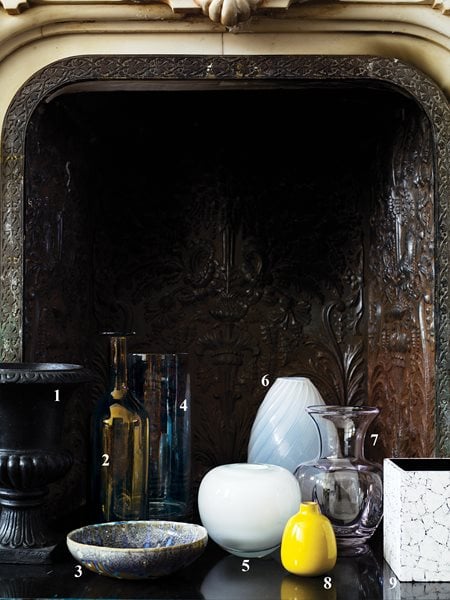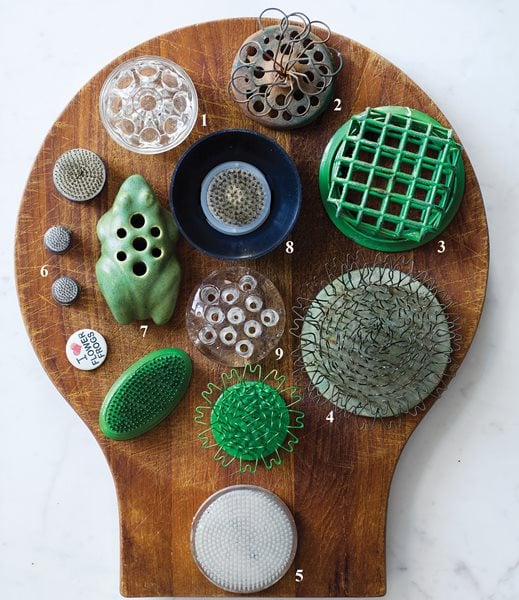Flower Arranging 101
Creating striking arrangements doesn't take a genius—or a florist. Our step-by-step guide about how to DIY flower centerpieces at home.

Like good china and certain relatives, flower arrangements are often regarded with a strange mixture of affection and trepidation. Trotted out on special occasions, they are admired, praised, and then hastily retired. But it’s not this way everywhere; in much of Europe, people routinely toss fresh flowers into shopping baskets alongside the milk. Following their lead (and thanks to the current mania in this country for all things DIY), this relaxed attitude has crossed the Atlantic to stateside floraphiles.
We've put together a short slide show showing everything you need, whether it's tools, long-lasting flowers and greens, vases, or flower frogs, to start making your own beautiful flower arrangements at home.

And so gardeners who are savvy about growing but little versed in tabletop composition are heading off to class. “Flower arranging has become much more popular in the past couple of years,” says Nicolette Owen, who, along with Sarah Ryhanen, runs the Brooklyn, New York–based Little Flower School, which offers courses like Ranunculus Revisited and Dutch Masters. And across the East River, in a shop in Midtown Manhattan, enrollment among twenty- and thirtysomethings is up at FlowerSchool New York. “It used to be like the garden club, but it’s become more hip,” says director Eileen Johnson. “People are interested in entertaining, and there’s a lot of crossover between cooking and entertaining and flowers.”
LONG-LASTING FLOWERS AND GREENS
1 Philodendron Waxy and tough, these leaves stay fresh for ages if you change the water regularly.
2 Calla lily Place several stems, cut to the same length, in a vase to create a clean, modern arrangement.
3 White Gerber daisy An alternative to the standard daisy, it bends playfully in different directions.
4 White chrysanthemum To avoid rot, remove all leaves that sit below the surface of the water. This applies to all flowers.
5 Anthurium Leave stems long and arrange in a tall, narrow vase.
6 Protea A single stem works well in a tall bottle or cut short in a bud vase.
7 Cymbidium orchid Float flowers in a low bowl, or mix whole stems with assorted leaves.
8 Button chrysanthemum Use these blooms to add an informal wildflower note to arrangements.
9 Star of Bethlehem Arrange a few stems in a tall, narrow-neck vase. Cut fleshy stems regularly to keep flowers fresh.
10 Carnation Trim short and use to cover a mound of floral foam set in a low bowl.
11 Sea holly Its intense texture and blue color can offer a great contrast to more delicate blooms.
12 Waxflower Kept tall and loose, it adds a pretty, organic touch to a mixed arrangement.
13 Baby’s breath The parsley of flower arrangements, this often discarded floral garnish is very dramatic when massed in a black urn.

Even seasoned gardeners, used to planting flowers in quantity, might be at a loss when it comes to arranging them. But experts insist that such floralphobia is easily surmounted. Half the battle is realizing that the goal doesn’t have to be something elaborate or perfectly “done.” The current vogue for more organic, looser, less-formal constructions may help explain the burgeoning interest. “There’s a world of possibilities between buying an arrangement from a florist and just sticking a bunch of tulips in a vase,” says Johnson.
VASE VARIETY
1 Footed urn This extra-high piece from Jamali deftly showcases cascading vines. ($14; jamaligarden.com)
2 Bottle A narrow opening in a Mexican recycled glass bottle is good for a single stem. Group a set of bottles together. ($64; canvashomestore.com)
3 Low bowl Float hibiscus in Uko Morita’s Wrinkle Basket or insert foam to build a low arrangement. ($150; saranyc.com)
4 Glass cylinder Aero Studios’s vase is invaluable for framing flowers with clean-looking stems, like tulips or amaryllis. ($90; areostudios.com)
5 Narrow-neck sphere Drop a few poppy stems in this Janus et Cie number to create a modern look. ($224; janusetcie.com)
6 Tall, narrow-neck flute Any blooms with long stems, even wildflowers, will rise to the occasion in an egg flute. ($275; johnpomp.com)
7 Classic florist’s vase The flared neck of the Shelburne vase is kind to the novice arranger; it practically lays out the flowers for you. ($125; simonpearce.com)
8 Bud vase Show off a leftover sprig or a clipping from your garden in this tiny pot. ($22; heathceramics.com)
9 Horizontal box Stage a dramatic centerpiec with a linear grid of flowers inside. ($1,324; janusetcie.com)

Owen’s principles of design suggest a surprisingly straightforward process: Build a foundation using woody stems or branches, add showier blooms, and finish with gestural elements—smaller, wispier accents. Johnson advises beginners to keep it simple. “Color mixing is a skill that takes time, so stay as close to monochromatic as you can. Group flowers of the same type together, to avoid ending up with a polka-dot look.”
FLOWER FROGS
1 Clear glass This classic, slightly domed option is inconspicuous when used in a see-through bowl or vase.
2 Vintage loops The bendable, poseable wire loops can be separated to help space out stems.
3 Vintage mesh dome Use with thicker stems, such as on tulips, lilies, or heavy branches. If the arrangement is top-heavy, anchor the frog with floral adhesive.
4 Hairpin holder Vintage or new, this type of prop is the most versatile way to go: It can stage stiff stems and branches at any angle, which is especially useful for a low, table centerpiece arranged so a seated guest can see over it.
5 Vintage clear pin holder Another vintage choice that’s functional, it holds lightweight stems in a clear container.
6 Pin holders Tailor-made for ikebana, Japanese-style arranging, these can hold thin stems. The oval shape will fill oblong containers. Small ones are ideal for a bud vase.
7 Vintage ceramic This is a prime example of a highly collectible but not-so-functional frog.
8 Avon bowl The low plastic bowl with removable pin holders can hold water, eliminating the need for another container.
9 Vintage clear glass Like a lot of older models, this frog is best used with thick-stemmed flowers. It also makes a great paperweight.
Shop for new flower frogs at dorothybiddle.com. Look for vintage pieces on eBay.

Having the right tools also smooths the way and expands your sense of options. If you have a variety of vessels on hand and an awareness of the magic of floral foam, frogs, and wire, a bunch of flowers from the supermarket can seem a lot more appealing. Much like legendary florist Constance Spry, who believed that flower arranging shouldn’t be reserved for the rich, you might eventually find yourself exploring the creative potential of kale and gravy boats. As Spry herself said in 1957, all it takes is a few flowers and a little creativity to make anyone feel “like a millionaire for a few pence.”
TOOLS OF THE TRADE
1 Waxed green florist twine is great for tying bouquets and bunching branches.
2 Cling floral adhesive secures flower frogs in a container; use stretchy floral tape to hold bouquets or create a grid atop a vessel; waterproof Oasis tape anchors floral foam.
3 Floral netting can be shaped to fit inside a container and used to anchor thicker, heavier branches.
4 Oasis floral foam holds water and can be cut with a knife to fit any vessel; white goatskin gloves provide a good grip and protect hands from thorns and sap.
5 Paddle wire secures woody material and tethers wreaths; flower preservative contains germicides, acidifiers, and sugars to help prolong the life of the blooms.
6 A metal doily straddles a vase or bowl opening, holding stems and branches in place.
7 Use matches to sear the ends of milky-stemmed flowers, such as poppies, to increase their life span; a flower pick will anchor a short-stemmed bloom in foam; water tubes keep stems used in boutonnières hydrated; elastic bands secure bouquets and arrangements.
8 Cutting tools include, from left, a florist’s knife to quickly trim stems; wire cutters to clip floral wire; Japanese thread snips to perform delicate work; heavy-duty shears to tame thick stems; multipurpose scissors to cut almost anything; comfortable, lightweight pocket secateurs to hack through big branches.
9 Stem cleaners quickly and safely remove thorns from roses.
Shop for tools at dorothybiddle.com. Vessels are from Donna Karan Lenox tabletop collection and can be found at neimanmarcus.com.




